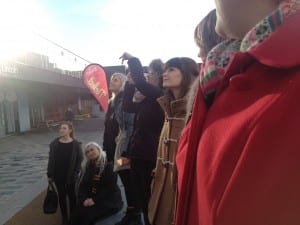The first lesson of Site Specific Performance was pretty daunting to me, especially with the given tasks of understanding such a broad subject. A subtle flash mob was first on the agenda, and the last thing I expected, during which I became less conscious of myself and more aware of what, where, how and who was in my surroundings.
A particular quest took my attention during my time, in what I thought was a familiar space. ‘An escape to the roof’. I began looking for ways in which I thought my small body could clamber up to what I first envisaged as safety. I looked for a stepping stone pattern, a secret stair case (in case I hadn’t noticed one before!) and objects that I could move towards the walls to make me tall enough. I drew a blank. I gave up and went on to take a picture of ‘an endless horizon’ which made me look at edges and lines of buildings where the sky met them. Suddenly through the camera lens everything changed, the Library that seemed so tall and void to my project became a miniature playground for my NEW legs… my fingers! The escape to the roof was no longer about being safe, it was about having fun. Without my camera perspective, who would have known?
The outcome I was so busy looking for was right under my nose, and arrived through divine intervention. In The Place of the Artist Govan explains that ‘Within contemporary performance, site-related work has become an established practice where an artist’s intervention offers spectators new perspectives upon a particular site or set of sites.’ (Govan, 2007, p.121) which was thought provoking; an artist’s intervention doesn’t simply have to be showing someone a new way of looking at something, it can be made through suggestion, timing and a sort of planned, hopeful coincidence of recognition.
A new found perspective can be continued through art. A new found favourite, and relevant, artist in mind is Slinkachu. Slinkachu is an artist that creates everyday tableaus of life size backgrounds with miniature people, here’s a few examples to enjoy!

http://slinkachu.com/little-people
Govan, E. Et al (2007) Making a Performance: Devising Histories and Contemporary Practices London and New York: Routledge



![IMG_0986[1]](https://sitespecific2015rba.blogs.lincoln.ac.uk/files/2015/01/IMG_09861-e1422466823390-225x300.jpg)
![IMG_0986[1]](https://sitespecific2015rba.blogs.lincoln.ac.uk/files/2015/01/IMG_09861-e1422467105878-225x300.jpg)
